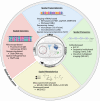Microbiome in cancer metastasis: biological insights and emerging spatial omics methods
- PMID: 40535543
- PMCID: PMC12174425
- DOI: 10.3389/fcimb.2025.1559870
Microbiome in cancer metastasis: biological insights and emerging spatial omics methods
Abstract
The role of the microbiome in cancer metastasis has emerged as a critical area of research, with growing evidence suggesting that microbial composition and interactions within the tumour microenvironment may significantly influence metastatic progression. This review explores the role of the microbiome in cancer metastasis, as well as potential key bacteria and their mechanisms through which they could impact tumour dissemination, seeding and growth. Biological models used to study metastasis are discussed to provide context for the further investigation of these interactions. In order to answer unresolved questions regarding the microbiome's involvement in metastatic dissemination, recent advancements in spatial biology techniques are examined, including spatial genomics, transcriptomics, proteomics and metabolomics, which enable the spatial mapping of microbial interactions within the tumour microenvironment. Additionally, multimodal-omics imaging approaches are highlighted for their potential to integrate multiple molecular layers, offering comprehensive insights into the microbiome's role in cancer metastasis. The review also addresses the challenges and limitations of these techniques, underscoring the complexity of studying microbiome-tumour interactions and offering directions for future research to better explore and target the microbiological landscape in metastatic cancer.
Keywords: cancer metastasis; host-microbiome interactions; microbiome; spatial omics; tumour microenvironment.
Copyright © 2025 Meyers, Stoffels, Frache, Letellier and Feucherolles.
Conflict of interest statement
The authors declare that the research was conducted in the absence of any commercial or financial relationships that could be construed as a potential conflict of interest.
Figures



Similar articles
-
Multi-omics approaches: transforming the landscape of natural product isolation.Funct Integr Genomics. 2025 Jun 19;25(1):132. doi: 10.1007/s10142-025-01645-7. Funct Integr Genomics. 2025. PMID: 40537580 Review.
-
Integrative systems biology approaches for analyzing microbiome dysbiosis and species interactions.Brief Bioinform. 2025 Jul 2;26(4):bbaf323. doi: 10.1093/bib/bbaf323. Brief Bioinform. 2025. PMID: 40619813 Free PMC article. Review.
-
The role of intratumoral microbiome in the occurrence, proliferation, metastasis of colorectal cancer and its underlying therapeutic strategies.Ageing Res Rev. 2025 Sep;111:102820. doi: 10.1016/j.arr.2025.102820. Epub 2025 Jul 8. Ageing Res Rev. 2025. PMID: 40639623 Review.
-
Characterizing the omics landscape based on 10,000+ datasets.Sci Rep. 2025 Jan 25;15(1):3189. doi: 10.1038/s41598-025-87256-5. Sci Rep. 2025. PMID: 39863642 Free PMC article.
-
Integrating Gut Microbiome and Metabolomics with Magnetic Resonance Enterography to Advance Bowel Damage Prediction in Crohn's Disease.J Inflamm Res. 2025 Jun 11;18:7631-7649. doi: 10.2147/JIR.S524671. eCollection 2025. J Inflamm Res. 2025. PMID: 40535353 Free PMC article.
References
-
- Ahkami A. H., Qafoku O., Roose T., Mou Q., Lu Y., Cardon Z. G., et al. (2024). Emerging sensing, imaging, and computational technologies to scale nano-to macroscale rhizosphere dynamics – Review and research perspectives. Soil Biol. Biochem. 189, 109253. doi: 10.1016/J.SOILBIO.2023.109253 - DOI - PMC - PubMed
-
- Akbari A., Galstyan A., Peterson R. E., Arlinghaus H. F., Tyler B. J. (2023). Label-free sub-micrometer 3D imaging of ciprofloxacin in native-state biofilms with cryo-time-of-flight secondary ion mass spectrometry. Anal. Bioanal. Chem. 415, 991–999. doi: 10.1007/s00216-022-04496-4 - DOI - PMC - PubMed
Publication types
MeSH terms
LinkOut - more resources
Full Text Sources
Medical

